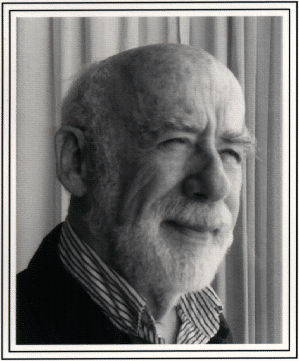 The nuke power industry now wants $50 billion and more in loan guarantees to build new atomic reactors. As it strong-arms Congress, the warnings of the great Dr. John Gofman, who passed away last week at 88, loom ever larger.
The nuke power industry now wants $50 billion and more in loan guarantees to build new atomic reactors. As it strong-arms Congress, the warnings of the great Dr. John Gofman, who passed away last week at 88, loom ever larger.One of history's most respected and revered medical and nuclear pioneers, Gofman's research showed as early as 1969 that "normal" radioactive reactor emissions could kill 32,000 Americans per year. At the time, Gofman was the chief medical researcher for the Atomic Energy Commission. He told the AEC that reactor emissions must be radically reduced.
The AEC demanded he change his findings, then forced him out when he refused. Since then, reactor backers have ceaselessly and erroneously attacked Gofman and his findings. But they could hardly have picked a more brilliant, committed opponent. Gofman was both relentless and uncorrupted. His findings should have doomed from the start an industry he called "insane."
In addition to being a world-class nuclear chemist, Dr. John William Gofman was one of history's most important heart specialists. His pioneer research helped define our modern understanding about cholesterol, distinguishing "good" fatty acids from bad. Gofman's astonishing medical discoveries remain at the core of today's common wisdom about diet and heart disease. For that work alone, Gofman was a towering figure.
Throughout his life, he was friend and peer to Nobel Laureates such as Linus Pauling and George Wald. But Gofman was also a nuclear chemist. As part of the Manhattan Project that built the first atomic bombs, his pioneer work helped lead to the discoveries of plutonium and certain isotopes of uranium.
Yet his career suffered from an inconvenient truth: when he discovered that atomic power plants kill people in large numbers, he refused to shut up about it. As a full professor at the University of California, Gofman's combined medical and nuclear credentials made him an obvious choice to manage health research for the Atomic Energy Commission, which both regulated and promoted the young nuclear power industry. When public questions were raised about the health impacts of radioactive reactor emissions, Gofman was dispatched to prove the industry safe.
But his findings showed that reactors are serious killers. So even Gofman's towering resume could not protect him from the wrath of an industry determined to build all the power plants it could. He and co-researcher Arthur Tamplin were driven from their jobs. When their POISONED POWER detailed the killing potential of atomic energy, Gofman and Tamplin were attacked mercilessly by an industry with immense investments to protect.
The experience showed that no matter how impeccable their credentials, and no matter how thorough their research, any scientists whose findings might indicate problems with atomic power would be automatically "discredited" by industry flacks to who did no comparable research. Even at his passing, the tired attacks on Gofman's findings have resurfaced. But his research remains the gold standard on the health impacts of radiation.
And as a gentle but firm advocate, mentor and friend, his integrity was matched only by his willingness to step outside traditional boundaries for what he believed. One of Gofman's most powerful and influential moments came in 1974, when he agreed to defend a civil disobedient named Sam Lovejoy in the small town of Montague, Massachusetts.
A member of a communal organic farm, Lovejoy had manually knocked over a 500-foot weather tower erected as a precursor to the building of a large twin reactor complex. Gofman agreed to testify in Lovejoy's defense, arguing that building two nuke reactors constituted a lethal threat to the health and safety of the community. In a monumental moment for the rise of the anti-nuclear movement, Lovejoy was acquitted.
Gofman's pivotal pronouncements appear in the award-winning LOVEJOY'S NUCLEAR WAR (gmpfilms.com), which has been shown all over the world. As a pivotal struggle over a "bailout in advance" for new reactor construction rages in Congress, Gofman's words resonate with a renewed critical importance:"
The decision to build nuclear power plants," he said, "may very well be, for the first time, a decision that can result in the desecration of the Earth with respect for life for all future generations. "Why do we want to put every city and hamlet of the United States at risk by building a thousand of these plants? We can get the power from sunshine, very easily and economically."
When we're talking about a mass of a hundred tons or so of material, melting 5,000 degrees Farenheit, with water around, with hydrogen being generated and burning explosively, melting through concrete into soil, when someone tells me that we're sure it isn't going to go far away, I say that I've heard various forms of insanity, but hardly this form."
Even if this hazard of a meltdown were securely answered, it doesn't alter for one second my opposition to nuclear power, because I'm concerned about the fact that whether it melts down or doesn't melt down, you 've created an astronomical amount of radioactive garbage which you must contain and isolate better than 99.99 percent perfectly, in peace and war, with human error and human malice, guerilla activity, psychotics, malfunction of equipment…do you believe that there's anything you'd like to guarantee will be done 99.99 percent perfectly for a hundred thousand years?"
After fifty years of proven failure, the nuke power industry is demanding still more taxpayer handouts to create still more of this waste. The great and good Dr. John W. Gofman warned us all against this insanity. His words and spirit remain at the core of what must be done to save this planet.
Posted by Harvey Wasserman








No comments:
Post a Comment